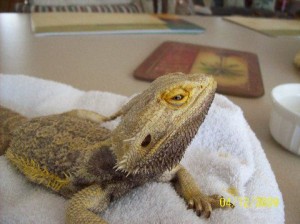 Testicular tumours are a relatively common affliction of older, intact male dogs seen in small animal practice. Seminomas, Sertoli cell tumours and interstitial cell tumours occur with roughly equal frequency. The incidence of tumours increases by 13-fold in cryptorchid testicles.
Testicular tumours are a relatively common affliction of older, intact male dogs seen in small animal practice. Seminomas, Sertoli cell tumours and interstitial cell tumours occur with roughly equal frequency. The incidence of tumours increases by 13-fold in cryptorchid testicles.
Not surprisingly, exotics are prone to similar afflictions, although the incidence of testicular tumours in reptile species is not well known.
Kristin Hall, associate veterinarian at Marathon Veterinary Hospital in Florida, recently diagnosed and treated a testicular tumour in a very unhappy pet bearded dragon. Marathon Veterinary Hospital is a general practice and referral centre, best known for its expertise in exotics. Practice Principal Douglas Mader is the author of Reptile Medicine and Surgery, the definitive reptile veterinary text. As a result, the practice attracts reptile referrals from near and far.
“We see anything and everything, including but not limited to dogs, cats, birds, reptiles, small mammals, primates, and wildlife,” Hall said.
“I also volunteer at the Sea Turtle Hospital to provide vet care for sick and injured sea turtles. One of the best things about my job is the variety of patients and cases we see. I have more of an interest in medicine than surgery; particularly oncology, so most of those cases are sent my way. The nearest boarded oncologist is two to three hours away, so it is a huge help to our clients when we can do their pet’s chemotherapy at our hospital.”
Bearded dragons and increasingly popular as pets all across the USA. Some experts predict that they will soon supplant the green iguana as the most popular pet reptile in that country.
At least where Hall is based that had already happened.
“We see a fair number [of bearded dragons] here,” she said. “Iguanas used to be common in the pet trade but these guys have kind of replaced them. Interestingly, the Florida Keys have a large wild green iguana population.”
Their unusual appearance, combined with a generally gentle temperament, has made them a particularly popular choice with owners who have no previous experience with reptiles. As a result, US-based exotics veterinarians are seeing increasing numbers.
But pet bearded dragons don’t always look like the bearded dragons we’re used to seeing in the wild. Like many Australian species kept as pets overseas, breeders have developed a range of unusual colours and varieties, including leatherbacks, which have a reduced number of tubercles or rough scales. Silkbacks don’t have scales or tubercles on their dorsum and ventral sides, with a total absence of lateral spines. This results in a more “vibrant” colouring.
Common afflictions of pet bearded dragons include metabolic bone disease, nutritional secondary hyperparathyroidism, gastrointestinal parasites (particularly coccidia, pinworms and trichomonad-like protozoa), hepatic lipidosis, respiratory infections, bacterial and fungal dermatitis, periodontal disease and, in females, follicular stasis and dystocia. In addition, bearded dragons housed together may inflict wounds on one another which require surgical debridement and antibiotic treatment.
ANNE FAWCETT

